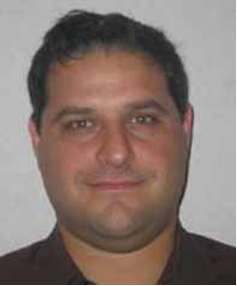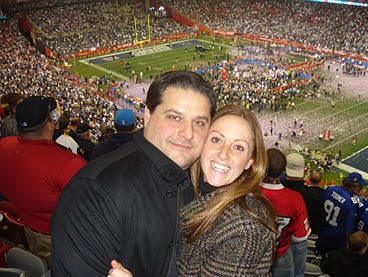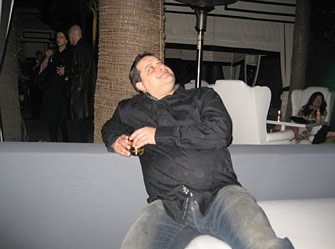
Abed Abusaleh from Euro RSCG is one of the very top media buyers from one of the top TV agencies so this was a pretty rare insight to get. Some Internet guys will be saying this is a pointless interview – but actually many direct response techniques we use to sell on the web came from TV. And these guys do a lot of volume, around $500M/year and run about 30% of the TV marketplace. Abed gives us an inside look at what it takes to get a show produced and enter the world of long-form (i.e. 30 min) infomercials. You can also find out how you can get your Internet products started on TV for $5k.
Full Interview Audio and Transcript
Personal Info
Hobbies and Interests: Softball Player, Plays on TV, Video Games, TV.
Favourite Sports Teams: New York Yankees, LA Lakers.
Favourite Books:
- Angels & Demons by Dan Brown.
Favourite Entrepreneurs: Steve Netzley, Warren Buffet.
Company Website: http://www.eurorscgedge.com/
Fast Track Interview
Adrian Bye: Abed Abusaleh has joined me for today’s interview. He works in the direct response television field. We have not yet had the opportunity to talk with someone in this field. Abed, can you tell us a little bit about who you are and what your company has done?
Abed Abusaleh: I am the Executive Vice-President of Long-Form Media for Euro RSCG. Basically, I head up the long-form television buying and planning division of our agency. As an agency, we do just over $500 million a year in both television and online advertising. Almost $400 million of that is television and direct response television advertising between long-form and short-form commercials. The other $100 million is split evenly between production and the online services we provide.
We place media in every media market across the country as well as on every national cable network. Steve Netzley and John Shearson started the agency 17 years ago out of a garage. Since then, we’ve had 17 consecutive years of growth.
Adrian Bye: Can you elaborate on the difference between long-form and short-form commercials?
Abed Abusaleh: Long-form is an infomercial that is 28 minutes and 30 seconds long. The short-form commercial is what people are most commonly used to seeing, which is a 30-second, 60-second or 2-minute advertisement. The long-form advertisement is used when you have a product that needs more explanation than what can be accomplished in a short-form advertisement.
If you’re doing a lead-generation spot for refinancing your home, the message can pretty much be accomplished in 30 seconds, 60 seconds, or two minutes. Long-form is used when you need to build the offer in a unique selling proposition where it takes the full 28 minutes and 30 seconds to explain the product you’re selling.
![]() For example, thousands of vacuums are on the market, but some of our clients have a unique selling proposition for the vacuums they are bringing to market. Maybe it’s a self-cleaning vacuum or the vacuum has a much higher power level than others. These messages usually take longer than a couple of minutes to explain and sell.
For example, thousands of vacuums are on the market, but some of our clients have a unique selling proposition for the vacuums they are bringing to market. Maybe it’s a self-cleaning vacuum or the vacuum has a much higher power level than others. These messages usually take longer than a couple of minutes to explain and sell.
Adrian Bye: You’re also bringing your television clients online, correct?
Abed Abusaleh: Very much so. A lot more people are completing their transactions online instead of picking up the phone and talking to a telemarketer. Integrating the online capabilities into your television ad campaign is the way the industry is heading and is essential for most people’s success.
Adrian Bye: What do you look for when you’re working with the client? How do you decide whether you want to work with someone?
Abed Abusaleh: There is no perfect screening process. There are times where people are just trying to throw something together and get it on the air. You really never want to burn a bridge in this industry. Often when people come in with a poor product or one we know probably doesn’t have a very good chance of success, we find that they are committed to the process.
While their first show fails, they meet others in the industry, they find a better producer, they surround themselves with a stronger team, and they develop and find a better product. Often their second or third foray into the space is much more successful. It’s rare for us to turn down a campaign because you never know what small fish ends up becoming the giant fish down the road.
Adrian Bye: You’ll then test any campaign?
Abed Abusaleh: There are certain things we won’t test across the barrier of what we know the stations will allow. For example, a lot of people will come to us with Girls Gone Wild knockoffs. We turn those shows down. There’s not a huge place for that in the marketplace. It’s a lot more headache than it’s worth, and it’s just not the type of product we really want to be associated with.
The only other reason we would possibly walk away from a product is if a client doesn’t have the funding to run a media test. For example, someone puts something together and wants to run a $500 test. If the client is not well-funded, they’re not seriously looking at their test. They’re just trying to throw something into the market and see if it sticks. We would probably walk away from something like that.
Otherwise, we would test most things. If somebody comes to us with a $5,000 to $10,000 budget, a show that’s produced, and is looking to see if it’s viable, the answer is yes. We would probably test it.
Adrian Bye: If I produce my show and come to you with $10,000 for a test, what do I receive?
 Abed Abusaleh: For $10,000, your test would include anywhere from 15 to 35 airings in local broadcast markets, probably smaller ones in the Southeast or Midwest. You probably wouldn’t be on somewhere like New York or Los Angeles. You would be on very small national cable stations if any.
Abed Abusaleh: For $10,000, your test would include anywhere from 15 to 35 airings in local broadcast markets, probably smaller ones in the Southeast or Midwest. You probably wouldn’t be on somewhere like New York or Los Angeles. You would be on very small national cable stations if any.
The idea is to get as many data points as possible on proven stations that have worked for DR TV to see if the show is at all viable. Those stations are vetted carefully to make sure they have proven history. If it works on those stations, then we can go on to other stations and expand them. If the test fails on those stations, you’re most likely not going to have a successful campaign. At that point, people usually go back to the drawing board or rework their show.
Adrian Bye: How much does it cost to have a show produced?
Abed Abusaleh: It depends. There are hundreds of producers in the industry. If you wanted to get a half-hour show produced through our agency, you’re probably looking at $300,000 to $600,000. This includes production costs and talent fees. There are producers in the industry that will do it for a lot less money. Some of them have not been successful though because the quality of the video tape is different or corners are cut in order to produce a bare-bones production.
Some clients produce shows internally for under $50,000. These resemble a CNN news format where you have one set, two people talking, and two or three cameras on them at all times. Then they edit the show later. Shows can be produced for as little as $30,000 to $40,000. I’ve also seen shows go up to $1.2 million in budget.
Adrian Bye: How does someone with a product that works well get started on TV?
Abed Abusaleh: Unless you’re familiar with the business, I wouldn’t invest $600,000 to $700,000 in a new infomercial out-of-the-gate. I would try to get it produced for as little as possible. The main thing I would suggest is that you spend your dollars wisely. Talk to as many agencies and producers as you can, so you’re making an informed decision and have a comprehensive perspective on the industry.
For example, if somebody comes to us and says, “I want you guys to help me,” I recommend that they also talk to three or four other agencies. I want them to know what the market has in store as well as know other opinions. I want them to work with us because they feel we have the best ideas.
Adrian Bye: Who are some of the clients you currently have?
Abed Abusaleh: Jordan Whitney and IMS are two tracking services that rank infomercials nationally on a weekly basis. We’re booking eight out of the top 25 infomercials in IMS. On Jordan Whitney, we’re booking 22 out of the top 60 shows. Based on our average spend, which is about $5.1 million a week in long-form billing alone, we estimate we comprise approximately 30 percent of the marketplace.
Some of the shows we have worked on include Euro-Pro, Body by Jake, Kodak, 6 Second Abs, Melt It Off with Mitch Gaylord, Contour Abs, and Works GT. We also work with a lot of business opportunities including Dean Graziosi’s program, The Real Estate Millionaire, the Better Trade Seminars, the Russ Whitney Seminars, and the Dynatech Seminars. We have a wide array of clients, and it’s a pretty diversified agency. There’s not one client in our agency that represents more than eight percent of our annual billing.
Adrian Bye: When we buy media on the Internet, we have a campaign and give it to someone else who monitors the numbers. Then we check in periodically on the campaign. Is it the same on TV?
Abed Abusaleh: It’s similar on TV except in direct response television everything you do is infinitely visible to a client. Within 24 hours of an airing, the client knows how the spot did, how much money it made, how much money it lost, and how many orders were received because of it. They have online visibility to their call centers, and they have a media schedule from us. Most clients know within 30 minutes how much money they made or lost.
Because our clients have such visibility to all of this, they’re very interactive in what we do with them. As a result, they influence the decisions we make. For example, they know the day of the airing how it did. If it worked, they want to know what future actions we’re going to take to get similar results. If it didn’t work, they want to make sure they’re not exposed to future media in that direction. It makes for a very fast-paced and sometimes high-stress environment.
Adrian Bye: Who tracks the results of the media buy?
 Abed Abusaleh: We do. On a daily basis, we “source” to find out how many orders came in, where they came from, and what media the orders are attributed to. We develop their overall revenue for the spot, cost per call, and cost per order. We then provide them with that information in a daily report. For example, “Yesterday, you spent $5,000 on these five stations and you made $15,000. Here’s what stations did well. Here’s what stations did poorly, and here’s what stations are on the bubble.”
Abed Abusaleh: We do. On a daily basis, we “source” to find out how many orders came in, where they came from, and what media the orders are attributed to. We develop their overall revenue for the spot, cost per call, and cost per order. We then provide them with that information in a daily report. For example, “Yesterday, you spent $5,000 on these five stations and you made $15,000. Here’s what stations did well. Here’s what stations did poorly, and here’s what stations are on the bubble.”
Adrian Bye: Why do they need to talk to you on a regular basis? Can’t they just check-in once a week or once a month?
Abed Abusaleh: Technically they could, but most people are extremely active in the businesses they run. You’re dealing with a lot of entrepreneurs who want to know every detail no matter the size of the business. They’re intricately involved with every aspect of the process. Honestly, those are the types of clients we work best with because their passion and our passion usually produces a winning formula.
Adrian Bye: How do you buy media? On the Internet, we talk about CPM, and we always back towards CPA. Is that not what you’re doing when you buy on TV?
Abed Abusaleh: We don’t buy on CPM. It is supply and demand. We work off a database that has over $2 to $3 billion in media history. Our system tracks every station we’ve ever run, every rate we’ve ever paid, and how the shows have performed over the past 17 years. From that, we’ve developed a target rate by station and identified where things probably work, and where the majority of your products have the best chance of success.
When we’re negotiating with stations, our goal is to get media at a rate that makes sense for the products we have and for how the time period performs. Time periods have a value. Since infomercials are not rated, there’s no way for them to know how many people are or aren’t watching. The only thing you can default to is response. For example, “This time period traditionally has this much response for this type of product. It normally responds to this type of dollar figure at this type of product.”
That’s how we get a rate understanding of whether this spot is worth $300, $500, or $1,000. The entire industry negotiates time on historical responses, not eyeballs.
Adrian Bye: How are spots sold? Is there an auction or bidding system for spots?
Abed Abusaleh: About 10 percent of the spots are sold via auction where the highest bidder gets the spot. I like to avoid those stations because, frankly, their inventories are usually overpriced.
The other 90 percent are sold on a package basis or an incumbency basis, which means agency “A” previously had these spots and has the first right of refusal on those spots for the second quarter. In other words, blocks of time are allotted to agencies on most of these stations, and as long as those agencies keep them for the quarter, they usually have the first right of refusal for the following quarter.
Adrian Bye: What products currently work best on TV?
Abed Abusaleh: Housewares, hardwares, and electronics have had a major comeback in 2008. These are things for your home, such as vacuum cleaners, hedge trimmers, work benches, drill sets, and computers. It’s good to see the consumer goods come back because there’s a high demand for those products right now. This industry has been dominated for so long by business opportunity and fitness.
Business opportunity shows were at one point spending over $150 million to $200 million a year in television long-form alone. This included opportunities such as “Come to this hotel and learn how to trade real estate.” They had such a huge appetite for media buys that it almost artificially inflated the rates and priced out the direct-to-consumer products. That industry has probably decreased by about 80 percent over the last year and a half. The direct response industry has almost come back to a fairer playing field for the rest of the people who are trying to purchase time.









